CANYVAL-X (CubeSat Astronomy by NASA and Yonsei using Virtual Telescope Alignment eXperiment)
Non-EO
NASA
KARI
Astronomy and Telescopes
Quick facts
Overview
| Mission type | Non-EO |
| Agency | NASA, KARI |
| Launch date | 12 Jan 2018 |
| End of life date | 24 Feb 2018 |
CANYVAL-X (CubeSat Astronomy by NASA and Yonsei using Virtual Telescope Alignment eXperiment)
Spacecraft Launch Mission Status Sensor Complement References
CANYVAL-X is a collaborative nanosatellite technology constellation of NASA, Korea's Yonsei University and the KARI (Korea Aerospace Research Institute) with the goal of demonstrating the Vision Alignment System by maintaining flight formation of two separated CubeSats and ultimately prove a possibility of a virtual telescope system which is consistant of the optic satellite to focus a light from the sun and the detector satellite.
NASA engineers Neerav Shah and Phil Calhoun will realize a long-held ambition later this year when a Space-X launch vehicle deploys two tiny satellites that will fly in a precise formation to create, in effect, a single or "virtual" telescope benefitting a range of scientific disciplines. Through a NASA international agreement, Shah and his team have partnered with South Korea's Yonsei University and the KARI (Korea Aerospace Research Institute) to validate technologies that would allow a pair of miniature spacecraft to fly in tandem along an inertial line of sight toward the sun and then hold that configuration — a feat not yet performed in space. 1) 2)
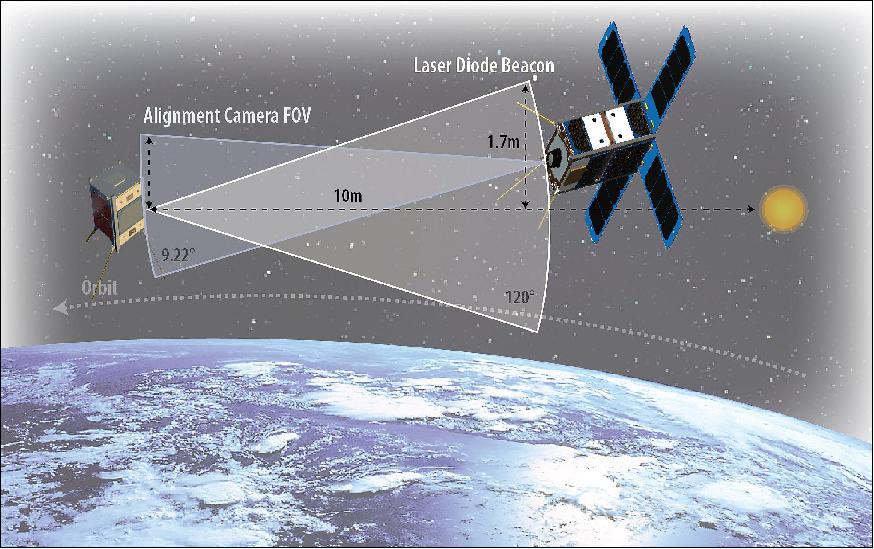
"The key differentiator with our mission is that we are attempting to align two satellites along an inertial line of sight to a distant celestial target and hold them in alignment for a long enough time to make a science measurement," said Shah, an engineer at NASA's Goddard Space Flight Center in Greenbelt, Maryland. "Although others have flown two or more satellites in tandem, we are the first in the world to even try holding them in alignment to a distant source."
Currently, ESA (European Space Agency) is developing PROBA-3, a minisatellite science experiment that will fly a pair of satellites in a tight formation to form a solar coronagraph at a distance of 250-500 m to study the sun's faint corona, the outer atmosphere. Unlike CANYVAL-X, which is designed to test only the alignment technologies, PROBA-3 also will gather scientific measurements. According to ESA, however, the mission isn't expected to launch until the end of 2018.
The technology's obvious beneficiaries are scientists who study the sun's corona and more particularly coronal mass ejections that hurl enormous bubbles of superheated gas across the solar system. Traveling at 1.5 million km/h, they can disrupt low-Earth-orbiting satellites and terrestrial power grids when they strike Earth. The technology also could benefit scientists searching for planets beyond the solar system.
Both scientific disciplines rely on coronagraphs, which employ an occulter mask to block bright starlight to reveal faint objects hidden by the star's bright light and a camera or spectrograph to gather measurements. Today, spaceborne coronagraphs house both the occulter and a camera or spectrograph in the same telescope, positioning them relatively close to one another.
Spacecraft
CANYVAL-X is a technology demonstration CubeSat mission with a primary objective of validating technologies that allow two spacecraft to fly in formation along an inertial line-of-sight (i.e., align two spacecraft to an inertial source). Demonstration of precision dual-spacecraft alignment achieving fine angular precision enables a variety of cutting-edge heliophysics and astrophysics missions. 3) 4)
Under the collaboration established by the international agreement, Yonsei and KARI are providing the two spacecraft, a 1U and a 2U CubeSat, integrating the Goddard-supplied sun sensor and GWU-Goddard µCAT system, and launching the spacecraft.
GWU (George Washington University) Micro-propulsion and Nanotechnology Lab:
• Developed the µCAT (micro Cathode Arc Thruster) system analog electronics and control design, based on the system developed for the BRICSAT mission (launch 2015) of the U.S. Naval Academy.
• Delivered the µCAT thruster heads
Yonsei University:
• Designed, built, and tested the 1U and 2U spacecraft and integrated the µCAT system.
• Spacecraft environmental testing at KARI.
• Developed ground system to conduct mission operations and alignment experiment.
NASA:
• Delivered the Miniature Fine Sun Sensor – provides attitude measurement for the 2U CubeSat.
• Conducting an assessment of CANYVAL-X's GN&C in regards to formation acquisition and alignment.
• Traveled to Yonsei to collaborate with team.
Parameter | Jerry (1U CubeSat) | Tom (2U CubeSat) |
Mission life time | 3-6 months | |
Payload | 3 Laser Diodes | Visible Camera (NanoCam) |
Payload performance | Half Intensity Beam | 2048 x 1536 pixels, CMOS sensor |
GN&C | (Magnetorquer, sun sensor) | µCAT, Sun Sensor, Nano-Cam, reaction wheels, magnetorquer |
Data rate | Up/downlink: 4.8 kbit/s (UHF) | Uplink: 4 kbit/s (UHF), Downlink 100 kbit/s (S-band) |
Mass | 1.0 kg | 2.7 kg |
Relative distance | > 10 m (collision avoidance) | |
Orbit control | GWU | 20 cm (1 DOF µCAT x 4 + 3-axis reaction wheel) |
Orbit determination | Each axis ± 10 cm (GPS) | |
Attitude control | 5º (magnetorquer) 10 m x tan(5º) = 88 cm | 1º (reaction wheel) 10 m x tan(1º) = 18 cm |
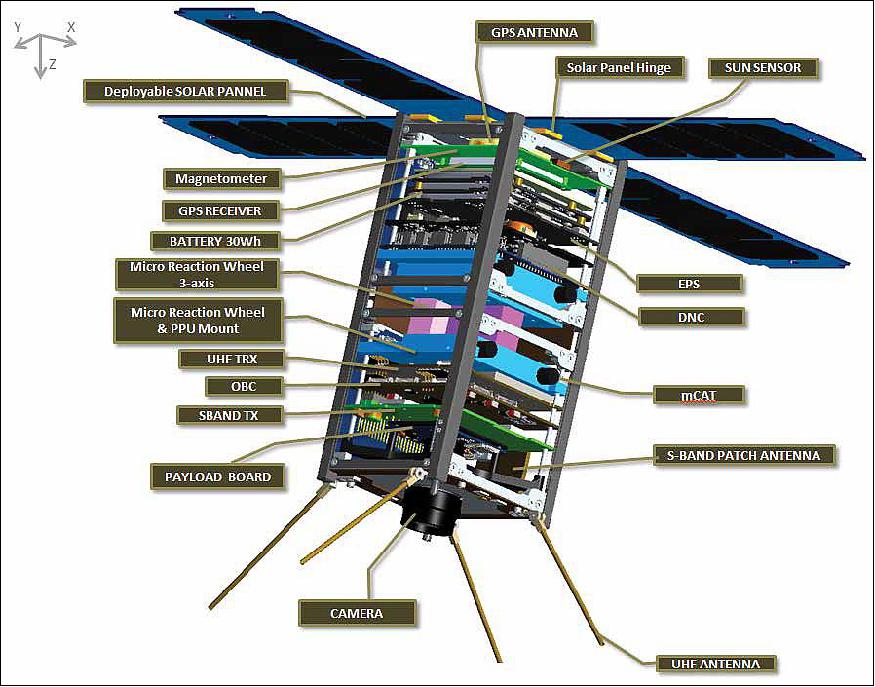
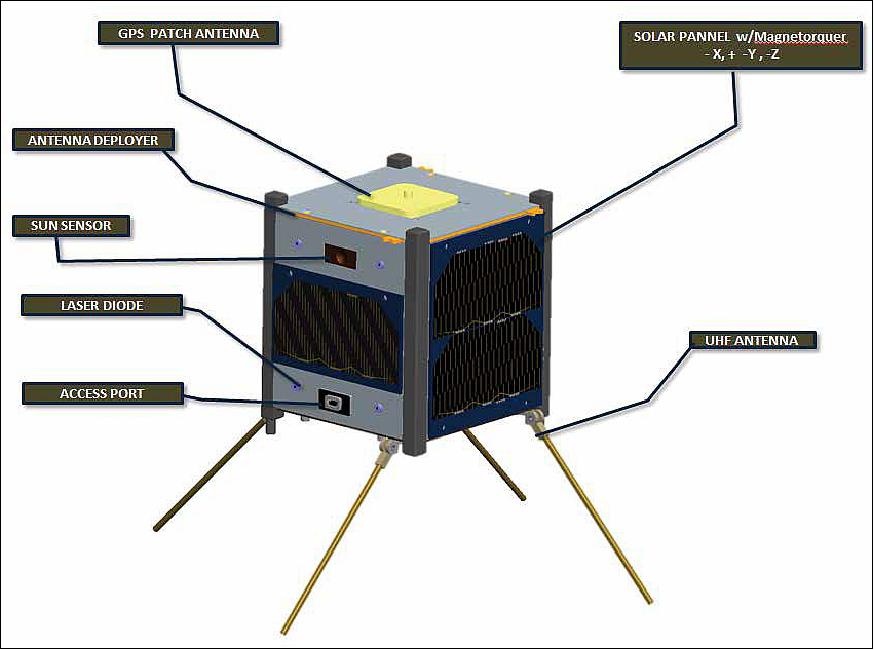
Launch
The CANYVAL-X CubeSats were launched as secondary payloads on 12 January 2018 (03:59 UTC) on the PSLV-40 flight vehicle (XL configuration) of ISRO. The launch site was the SDSC (Satish Dhawan Space Center) SHAR (Sriharikota) on the east coast of India. The primary payload on this flight was CartoSat-2F (formerly CartoSat-2ER) of ISRO with a mass of 710 kg. 5) 6)
Orbit: Sun-synchronous orbit with an altitude of 505 km and an inclination of 97.55º.
Secondary Payloads
The co-passenger satellites comprise one microsatellite and one nanosatellite from India as well as one minisatellite plus 2 microsatellites and 25 nanosatellites from six countries, namely, Canada, Finland, France, Republic of Korea, UK and USA. The total mass of all the 31 satellites carried onboard PSLV-C40 is about 1323 kg.
The 28 international customer satellites are being launched as part of the commercial arrangements between Antrix Corporation Limited (Antrix), a Government of India company under Department of Space (DOS), the commercial arm of ISRO and the International customers.
Out of the 31 satellites, 23 were integrated on the rocket (and subsequently successfully deployed into orbit) using the ISISpace' QuadPack CubeSat deployers and relied on the ISISpace sequencing electronics for the timely deployment. With the success of this campaign, ISIS (Innovative Solutions In Space) of Delft, The Netherlands, has reached a total of 256 satellites sent to space and 197 QuadPack doors successfully opened.
• TeleSat LEO Phase 1, a communications minisatellite mission (168 kg) of Telesat Canada, built by SSTL, Surrey, UK.
• Carbonite-2, a microsatellite (~100 kg) of SSTL (X50 platform) to demonstrate video performance for the future Earth-i Vivid-i constellation. Earth-i is located at Surrey Research Park, Guildford, UK.
• IITMSAT [IIT (Indian Institute of Technology) Madras Satellite], also referred to as INS-1C, a student built microsatellite (11 kg) to study the energy spectrum of charged particles in the upper ionosphere.
• Microsat of ISRO in the 100 kg class, that derives its heritage from IMS-1 bus. This is a technology demonstrator and the forerunner for future satellites of this series. The satellite bus is modular in design and can be fabricated and tested independently of payload. 7)
• PicSat, a 3U CubeSat (3.5 kg) of the Paris Observatory, France. PicSat is an astronomy mission to measure exoplanetary transits.
• CANYVAL-X, 1, 2, a technology demonstration CubeSat mission (1U and 2U CubeSats) of Korea's Yonsei University and KARI (Korea Aerospace Research Institute) in collaboration with NASA; the goal is to demonstrate a Vision Alignment System.
• CNUSail-1 (Chungnam National University Sail-1), a 3U CubeSat solar sail test of Chungnam National University, Korea (4 kg).
• KAUSAT-5 (Korea Aviation University Satellite), a 3U CubeSat (4 kg) to observe the Earth with an IR camera and measure the amount of radiation around LEO.
• SIGMA (Scientific cubesat with Instruments for Global magnetic field and rAdiation) or KHUSAT-3 (Kyung Hee University Satellite-3), a 3U CubeSat to measure the global magnetic field and radiation.
• STEP CubeLab (Space Technology Experimental Project CubeSat Laboratory), a 1U CubeSat of Chosun University, Gwangju, Korea. The objective is to exploit core space technologies researched by domestic universities and verify the effectiveness of these technologies through on-orbit tests using the CubeSat.
• ICEYE-X1, Finland's SAR (Synthetic Aperture Radar) microsatellite with a mas of <100 kg.
• CICERO-7, a 6U CubeSat (~10 kg) of GeoOptics, USA, built by Tyvak, to demonstrate radio occultation observations.
• Arkyd-6A, a 6U CubeSat of Planetary Resources Inc., USA (formerly Arkyd Astronautics) to test attitude control, power, and communication systems as well as a photo-display-and-retransmission system.
• Fox-1D, a radio amateur and technology research 1U CubeSat, developed by AMSAT, USA and hosting several university developed payloads (University of Iowa, Virginia Tech, and Pennsylvania State-Erie).
• Lemur-2 x 4, 3U CubeSats of Spire Global Inc., San Francisco, CA.
• Landmapper-BC3 (Corvus-BC3), a 6U CubeSat (10 kg) of Astro Digital (former Aquila Space), USA to provide multispectral imagery of 22 m resolution on a swath of 220 km.
• MicroMAS-2a, a 3U CubeSat mission (3.8 kg) of MIT/LL (Massachusetts Institute of Technology/Lincoln Laboratory) of Lexington, MA, USA. Test of a compact microwave spectrometer and radiometer payload in orbit.
• SpaceBEE x 4 picosatellites, built to 0.25 CubeSat form factor, a technology demonstration, USA
• Flock-3p x 4, 3U CubeSats of Planet, San Francisco, USA.
• Tyvak 61C, a 3U CubeSat and a technology demonstration and astronomy mission of Tyvak Inc., Irvine CA, USA.
Mission Status
• May 2018: The CubeSat Yonsei team designed the operational scenario and developed automatic communication programs to manage normal CubeSat operation. After 43 days from the launch, the first beacon signal from the 2U CubeSat was received at the ground station of Yonsei University, Korea. The ping between the CubeSat and the ground station was used to check the FM communication. Repetitive attempts were made to download the log file from the first reception of the beacon signal. Currently, telecommand and telemetry are not carried out successively since the FM communication of the ground station is acting abnormal. From these experiences during the early operation of CANYVAL-X, the CubeSat Yonsei team learned valuable lessons for the future mission such as the beacon carriage and the storage management design strategy. 8)
- After May 2018, it is expected that the two CubeSats will separate automatically without telecommand from the ground station. A new beacon signal will be sent by the separated CubeSats, from which we will attempt to obtain telemetry information.
Sensor Complement
The 2U CubeSat will carry two Goddard-provided technologies that make up the mission's all-important GN&C (Guidance, Navigation and Control) system: a miniature sun sensor and the micro cathode arc thruster (µCAT) system. Developed at the Wallops Flight Facility in Virginia's Eastern Shore, the sun sensor calculates a direction to the sun. The George Washington University (GWU)-designed the µCAT (micro-Cathode Arc Thruster) system, which is about the size of a coffee mug, fires its thrusters to move the spacecraft so that it maintains its alignment with the 1U CubeSat separated by about 10 m.
µCAT: Recent advancements in miniaturization, with volumes less than 6 cm x 9 cm x 9 cm, for four independent channels, increased performance of 2 µNs per impulse-bit can be reported, as well as the ongoing work towards expanding the operating range from 1 Hz to 50 Hz with new controller functionality: power management, power distribution, event signaling, command and data handling (specific impulse of 2000 to 3000 seconds). Computer models have been developed to generate physical and volumetric requirement arrays and cluster arrangements of µCAT elements to create a whole subsystem for a given delta-V and thrust levels, and EMI studies are in progress. 9) 10) 11)
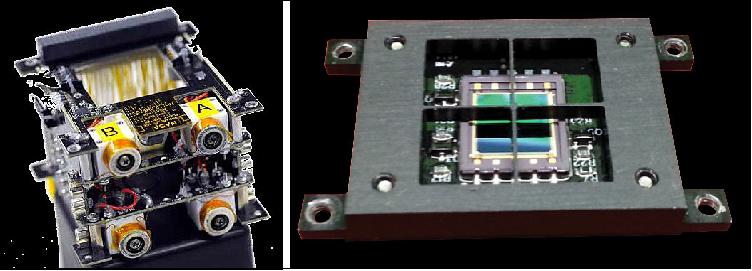
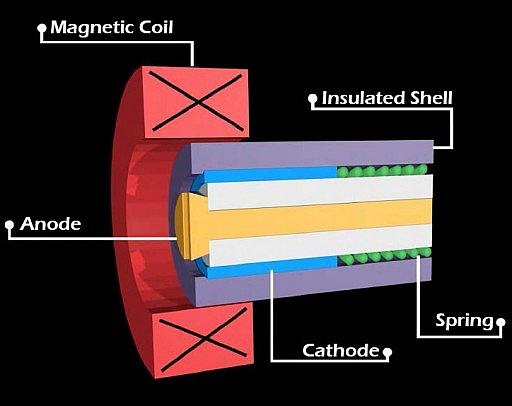
References
1) Lori Keesey, "NASA Engineer Awaits Launch of CubeSat Mission Demonstrating Virtual-Telescope Tech," NASA, Feb. 18, 2016, URL: https://www.nasa.gov/feature/goddard/2016/nasa-engineer-awaits-launch-of-cubesat-mission-demonstrating-virtual-telescope-tech
2) "CANYVAL-X: CubeSat Astronomy by NASA and Yonsei using Virtual Telescope Alignment eXperiment," NASA, Oct. 13, 2015, URL: https://svs.gsfc.nasa.gov/cgi-bin/details.cgi?aid=12025
3) "NASA Fact Sheet," URL: https://svs.gsfc.nasa.gov/vis/a010000/a012000/a012025/FactSheet_v12.pdf
4) Neerav Shah, Joe Davila, Phil Chamberlin, Phil Calhoun, "Next-Generation Formation Flying Solar Coronagraph," Proceedings of iCubeSat 2014, 3rd Interplanetary CubeSat Workshop, Pasadena, CA, USA, May 27-28, 2014, URL: https://icubesat.files.wordpress.com/2014/05/icubesat-org_2014_b-3-2-coronagraph_shah_201405281756.pdf
5) "PSLV Successfully Launches 31 Satellites in a Single Flight," ISRO, 12 Jan. 2018, URL: https://www.isro.gov.in/2018press15.html
6) Stephen Clark, "India's PSLV lifts off on first flight since fairing failure," Spaceflight Now, 12 January 2018, URL: https://spaceflightnow.com/2018/01/12/pslv-c-40-coverage/
7) "Microsat," ISRO, 12 Jan. 2018, URL: https://web.archive.org/web/20180125015338/https://www.isro.gov.in/Spacecraft/microsat-0
8) Youngbum Song, Sang-Young Park, Youngro Lee, Jae-Pil Park, "CANYVAL-X: Operational Scenario and Strategy," SpaceOps Conference, Marseille, France, 28 May - 1 June 2018, URL: https://arc.aiaa.org/doi/pdf/10.2514/6.2018-2636
9) Samudra E. Haque, Christopher K Dinelli, "Preliminary sizing of a Micro-Cathode Arc Thruster subsystem for operations in cis-lunar space," 2014, URL: https://web.archive.org/web/20160322154635/http://lunar-cubes.com/docs/Hague2014%20LunarCubes%20Abstract%5B1%5D.docx
10) Michael Keidar, "Micro-Cathode Arc Thruster for small satellite propulsion," Aerospace Conference, 5-12 March 2016, Big Sky, MT, USA, IEEE, DOI: 10.1109/AERO.2016.7500506
11) Michael Keidar, T. Zhuang, S. Haque, A. Shashurin, G. Teel, D. Chui, J. Lucas, C. Parvini, J. Slotten, "Micro-Cathode Arc Thruster for Nanosatellite Propuslion," Proceedings of the 27th AIAA/USU Conference, Small Satellite Constellations, Logan, Utah, USA, Aug. 10-15, 2013, URL: https://digitalcommons.usu.edu/cgi/viewcontent.cgi?referer=&httpsredir=1&filename=0&article=2964&context=smallsat&type=additional
The information compiled and edited in this article was provided by Herbert J. Kramer from his documentation of: "Observation of the Earth and Its Environment: Survey of Missions and Sensors" (Springer Verlag) as well as many other sources after the publication of the 4th edition in 2002. - Comments and corrections to this article are always welcome for further updates (eoportal@symbios.space).
Spacecraft Launch Mission Status Sensor Complement References Back to top